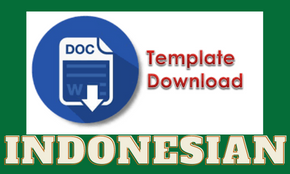Please use the following guidelines to prepare your manuscript before sending it.
| Title |
| Title Using Verdana Regular Font with 24 pts and maximal 16 Words |
| Author1* , Author2 , Author3 , Author4 , Author5 |
| 1,2,3Study Program, Affiliation, Country |
| 4,5Study Program, Affiliation, Country |
| 1*email@email.com, 2email@email.com, 3email@email.com, 4email@email.com, 5email@email.com |
| The title should be clear and concise. Only the beginning of the title uses capital letters and is not bold. The author's name and affiliation as written above. The author's name is written clearly without a title. |
| Abstract |
| Abstracts are written in two languages: English and Indonesian, with a maximum of 200 - 250 words in Indonesian. If the manuscript is in English, the abstract is simply written in English with Verdana 10, spaced 1, one paragraph, italic printed for abstract [English] and straight print [Indonesian] with one-column format. |
| Keywords: Component; formatting; style; styling; insert (maximum 5 keywords). |
| INTRODUCING |
| In the introduction, researchers are expected to be able to explain the existing phenomena or background information such as prior work, hypotheses, problems to be discussed. This is followed by a statement of the purpose of the research issue or problem and/or set of questions you attempt to answer in your research. |
| RESEARCH METHODOLOGY |
| In this section, each researcher expected to be able to make the most recent contribution related to the solution to the existing problems. Researchers can also use images, diagrams, and flowcharts to explain the solutions to these problems. |
| RESULT AND DISCUSSIONS |
| In this section, the researcher will explain the results of the research obtained. Researchers can also use images, tables, and curves to explain the results of the study. These results should present the raw data or the results after applying the techniques outlined in the methods section. The results are simply results; they do not conclude. In this section, the researchers can give a simple discussion related to the results of the research trials. This section contains the author's opinion about the research results obtained. Common features of the discussion section include the comparison between measured and modeled data or comparison among various modeling methods, the results obtained to solve a specific engineering or scientific problem, and further explanation of new and significant findings |
| CONCLUSION |
| The conclusion contains a summary of what is learned from the results obtained, what needs to be improved in further study. Other common features of the conclusions are the benefits and applications of the research, limitation, and recommendations based on the results obtained. |
| ACKNOWLEDGMENT (Optional) |
| The acknowledgments are given at the end of the research paper and should at a minimum name the sources of funding that contributed to the article. You may also recognize other people who contributed to the article or data contained in the article but at a level of effort that does not justify their inclusion as authors. You may also state the research grant contract number if any. |
| REFERENCES |
| All reference citations cited in this article use reference tools such as MENDELEY with IEEE format, 80% of the literature within the last 10 years at least. The minimum number of references used is 15 references. |


.png)

